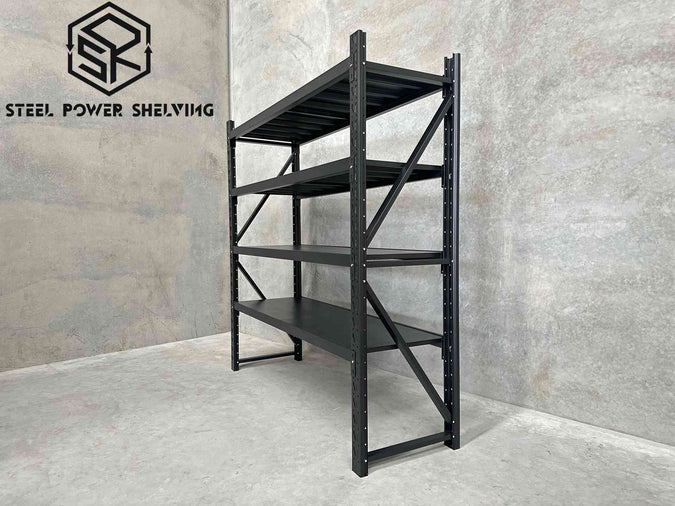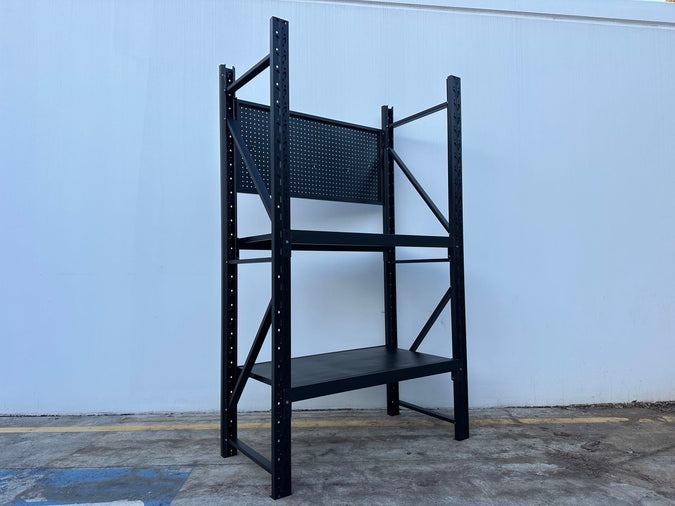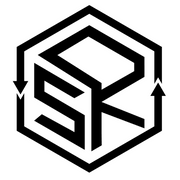Table of Contents
- Introduction to Warehouse Racking Systems
- Factors Influencing Warehouse Racking Price
- Types of Warehouse Racking Systems
-
Top Warehouse Racking Options in 2025
- Steel Power Shelving Shelf (2.0m H x 2.0m L x 0.6m D)
- Steel Power Shelving Workstation with Pegboard (2.0m H x 1.2m L x 0.6m D)
- How to Calculate Warehouse Racking Price per Square Foot
- Warehouse Racking Costs by Square Foot in 2025
- Why Warehouse Racking is Essential for Efficient Storage
- FAQs about Warehouse Racking in Australia
- Table: Pricing Overview of Warehouse Racking Systems in Australia
Introduction to Warehouse Racking Systems
Warehouse racking systems are essential components of modern storage and logistics operations. Whether you're running a warehouse, a distribution center, or a retail stockroom, choosing the right racking system can drastically improve your storage capacity and overall workflow efficiency. One of the most important considerations when selecting a racking system is the cost per square foot. This price will vary depending on the type of racking, materials used, and other factors such as assembly costs and system flexibility.
In this article, we will explore the warehouse racking prices in Australia for 2025, factors that influence these prices, and two top warehouse racking options to consider. Additionally, we will provide a detailed guide on how to calculate warehouse racking costs per square foot and compare the prices of popular racking systems.

Factors Influencing Warehouse Racking Price
Several factors affect the overall cost of warehouse racking systems. These include:
1. Type of Racking System
The type of racking system plays a major role in determining its price per square foot. Common types of racking include:
- Selective Racking: Standard, cost-effective racking used for storing palletized goods. It offers easy accessibility but is less space-efficient compared to other systems.
- Drive-In Racking: Allows high-density storage with forklifts accessing racking lanes from one side.
- Push Back Racking: Suitable for high-density storage, allowing pallets to be stored and retrieved in a way that maximizes space.
- Cantilever Racking: Ideal for storing long, bulky items like pipes or timber.
Each type of racking system has different price points, and its suitability depends on the specific needs of your warehouse.
2. Material Quality
Warehouse racks are usually made of steel, which comes in varying thicknesses and qualities. The stronger and thicker the material, the higher the price. High-quality, durable materials also contribute to a longer lifespan and greater load-bearing capacity.
3. Size and Dimensions
Larger racking systems that offer more storage space or are designed for high-capacity operations tend to have higher prices per square foot. For instance, racks with wider bays or extended heights can accommodate more inventory but will come at a premium.
4. Customization and Accessories
Customized racking systems with special features like adjustable heights, special coatings (e.g., powder-coated finishes), or pegboards for tools can increase costs. Accessories such as extensions, additional shelves, and add-on kits can also add to the overall price.
5. Assembly and Installation Costs
While many warehouse racking systems come with easy-to-assemble features, complex configurations may require professional assembly, which adds an additional cost. It's important to factor in these fees when calculating the total cost.
Types of Warehouse Racking Systems
There are several types of warehouse racking systems, each designed to serve different purposes. Below are some of the most popular systems:
1. Selective Racking
This is the most common type of racking system and is highly versatile. It provides easy access to all pallets but is less dense compared to other options. It's best suited for warehouses that need quick access to stock.
2. Pushback Racking
A pushback racking system allows for high-density storage. Pallets are placed on a series of rolling rails, and the next pallet pushed into position displaces the previous one to the back.
3. Drive-In and Drive-Through Racking
These racking systems offer a high density of storage by allowing forklifts to drive into the racking lanes. In the drive-in system, the forklift only enters from one side, while the drive-through system allows entry from both sides.
4. Cantilever Racking
Designed for long, bulky items, cantilever racks have no front posts, allowing long objects such as pipes, timber, and metal sheets to be stored securely.
Top Warehouse Racking Options in 2025
Let's take a closer look at two excellent warehouse racking systems available in 2025.
Steel Power Shelving Shelf (2.0m H x 2.0m L x 0.6m D)

Price: $215.00
Max Load Capacity: 1200kg
Key Features:
- Material Thickness: 0.7 mm for uprights and beams, 0.4 mm for panels
- Size: 2.0m (Height) x 2.0m (Length) x 0.6m (Depth)
- Shelves per Bay: 4 shelves
- Assembly: Super easy with a click-in system, no tools required
- Extendable Shelving System: Offers flexibility with available add-on kits (extensions) of 1.2m, 1.5m, and 2.0m.
- Premium Grade Coating: Powder-coated finish for durability
- Metal Shelves Included: Designed to handle heavy loads
This shelving system is perfect for warehouses looking for a flexible and affordable shelving option. The adjustable shelves and easy-to-assemble design make it ideal for various types of storage needs.
Steel Power Shelving Workstation with Pegboard (2.0m H x 1.2m L x 0.6m D)

Price: $170.00
Max Load Capacity: 600kg
Key Features:
- Material Thickness: 0.7 mm for uprights and beams, 0.4 mm for panels
- Size: 2.0m (Height) x 1.2m (Length) x 0.6m (Depth)
- Shelves per Bay: 2 shelves with one pegboard
- Assembly: Easy-to-assemble click-in system
- Flexible Height: Adjustable shelves
- Add-On Kits: Available extensions (1.2m, 1.5m, and 2.0m)
- Premium Grade Coating: For added protection
This system combines a workspace with a pegboard and shelving, ideal for warehouses that need both storage and organization for tools and accessories. It’s a great choice for smaller warehouses or spaces where both shelving and workstations are required.
How to Calculate Warehouse Racking Price per Square Foot
To calculate the price of a warehouse racking system per square foot, follow these steps:
-
Measure the Total Area: Multiply the length and width of the racking system to find the total area it covers. For example, a shelf with dimensions 2.0m x 2.0m would cover 4 square meters.
-
Calculate the Price per Square Meter: Divide the price of the racking system by its total area in square meters. For instance, if the Steel Power Shelving Shelf costs $215.00 and covers 4 square meters, the price per square meter would be $215.00 / 4 = $53.75.
-
Convert to Square Feet: Since warehouse space is usually measured in square feet, multiply the price per square meter by 10.764 (the number of square feet in a square meter). In this case, $53.75 x 10.764 = $578.04 per square foot.
Warehouse Racking Costs by Square Foot in 2025
In 2025, the cost of warehouse racking in Australia generally ranges from $50 to $100 per square foot, depending on the type, quality, and customization of the racking system. Here's a rough estimate for different types:
- Basic Steel Shelving: Around $50 to $75 per square foot
- Selective and Drive-In Racking Systems: Approximately $70 to $90 per square foot
- Customizable and High-Density Systems: Can cost upwards of $90 per square foot
These prices include basic installation, but additional features like customization or specialized coatings can increase the cost.
Why Warehouse Racking is Essential for Efficient Storage
Warehouse racking systems optimize storage, maximize space utilization, and improve workflow efficiency. Well-designed racks allow for easy access to inventory and can help reduce the time spent searching for items. Additionally, racking systems contribute to better organization, which improves safety and reduces the likelihood of accidents.
FAQs about Warehouse Racking in Australia
1. How long does warehouse racking last?
Warehouse racking systems are typically designed to last for many years, often 10-20 years, depending on the material quality and how well they're maintained.
2. Can I customize warehouse racking systems?
Yes, many warehouse racking systems offer customization options like adjustable shelves, additional shelves, or different materials, depending on your storage needs.
**3. Are there any installation costs for warehouse
racking?** Yes, depending on the complexity of the racking system, you may need to pay for professional installation. Some systems offer easy-to-assemble click-in mechanisms, which reduce installation costs.
Table: Pricing Overview of Warehouse Racking Systems in Australia
| Racking System | Dimensions | Max Load | Price (AUD) | Key Features |
|---|---|---|---|---|
| Steel Power Shelving Shelf | 2.0m H x 2.0m L x 0.6m D | 1200kg | $215.00 | Adjustable, extendable, easy assembly |
| Steel Power Shelving Workstation with Pegboard | 2.0m H x 1.2m L x 0.6m D | 600kg | $170.00 | Includes pegboard, adjustable shelving |
Conclusion
Selecting the right warehouse racking system involves considering various factors such as space, budget, and functionality. By understanding the price per square foot, you can make an informed decision and optimize your warehouse for better storage and workflow efficiency. Whether you're choosing a basic shelving system or a more customized, high-density racking solution, it's important to balance cost with quality to get the most value for your investment.

